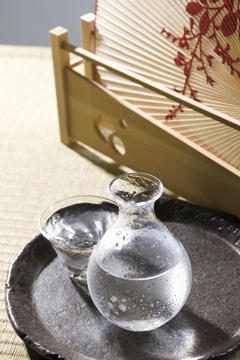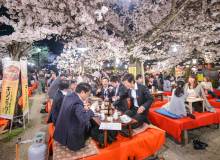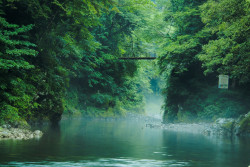
Originally published on metropolis.co.jp on August 2009
 Like almost everything in Japan, sake has its seasons. And also like almost everything in Japan, the issue of seasonal sake is laden with ambiguity. Just as this issue of Metropolis is coming out, we find ourselves wedged midway between two such nihonshu seasons: summer and autumn. As the sake appropriate for each is significantly different, let’s take a look at both.
Like almost everything in Japan, sake has its seasons. And also like almost everything in Japan, the issue of seasonal sake is laden with ambiguity. Just as this issue of Metropolis is coming out, we find ourselves wedged midway between two such nihonshu seasons: summer and autumn. As the sake appropriate for each is significantly different, let’s take a look at both.
First, summer sake. The heat and humidity render thick, rich or heavy drinks too overbearing and less refreshing than they would be in a cooler environment. And, needless to say, warmed sake hardly fits the bill—in fact, even room temperature leaves a bit to be desired. “Refreshing” is the key word here, conjuring images of chilled, clean and easy-to-drink sake.
With form following function, a commonly seen summer style is nama-zake (unpasteurized sake) with a slightly lower alcohol content, served well chilled. The fresh, zingy characteristics commonly found in nama-zake give a lightness and brightness to the drink, and certainly make it much more enjoyable cold than at any other temperature. And the lower alcohol content reduces the impact and any potential cloying tendencies, as well as allowing us to sip a bit more, and a bit faster with fewer, um, consequences.
Most sake is pasteurized twice by momentarily heating it up, providing stability to the flavors and aromas. Unpasteurized sake must be kept refrigerated to prevent its potential descent into a yeasty, undrinkable form. Nama-zake generally refers to sake in which both pasteurizations have been foregone.
Many brewers will offer a summer version of one of their mainstay products. Often, these are simply unpasteurized and very slightly watered down manifestations of normal brands created just for the summer months (for example, the alcohol content might be reduced from 16 to 14). While that may not seem like much, it can make the sake much more “gulp-able.” Also, these brands are sometimes only released locally rather than nationally, and in limited batches, so that when they’re gone, they’re gone. At this time of summer, there are surely some left, but to avail yourself of the opportunity you might want to hurry a bit. Should you miss ’em, a reputable nama-zake version of a light honjozo or ginjo grade should do you well in the zansho (remaining summer heat).
But autumn is just around the corner, and that season, perhaps, holds more traditional appeal than any other for nihonshu, being as it is the time when the previous brewing season’s sake is released. With refrigeration and the proliferation of diverse styles in recent years, fall doesn’t hold the significance it once did, but in the hearts of many it is still the finest season for sipping.
While sake is not usually aged beyond a year, it is possible to have some that is too young. Like wine, the flavors tend to compete with each other rather than harmonize. While just how long is needed depends on a myriad of factors, half a year is a typical minimum. So, long ago the fall became the standard time for showing off the results from the most recent round of brewing.
Sake released in the fall after this minimum aging period is often called aki-agari, a term that’s commonly seen on bottles. The phrase is, admittedly, a bit vague in its definition and is also exclusive of grade, so it might be of limited usefulness. But you can expect aki-agari sake to be youthful yet integrated, balanced not brash, and bright rather than bulky. All of this is, of course, relative to the original style of the brand in question.
Finally, one more seasonal type to look for is hiya-oroshi. This is almost a stop-gap between seasons, released anytime from late summer to early fall. Like aki-agari, it’s the previous season’s brew, but available a bit earlier and younger than aki-agari. Historically, hiya-oroshi refers to sake that was released just when the weather cooled down enough to the point where the sake did not need to be pasteurized the usual second time, thus preserving youth and vigor while ensuring stability.
What can you typically expect of hiya-oroshi sake? Youth and liveliness, if even a bit of brashness, but without the bursting woody aromatics of normal nama-zake. While hiya-oroshi is, like aki-agari, independent of grade, most if not all brewers that bother to release it use a premium grade, perhaps junmai-ginjo or thereabouts, ensuring a certain degree of satisfaction among fans.
Being as close as we are to the border between summer and autumn affords many opportunities—be they at sake pubs or respected retailers—to enjoy some of the seasons’ best offerings. Start enjoying them now, and keep enjoying them well into the late fall.
To sign up for notices of sake seminars and events in Tokyo, as well as a free newsletter about sake, go to www.sake-world.com.







